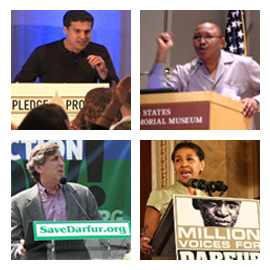Trackbacks
-
[…] The Promise of Engagement Investigating the past 6 years of Darfur policy and citizen advocacy Skip to content Bec HamiltonAuthor’s resumeAbout the projectAbout the interviewsUPCOMING PODCASTSSubmit a question « Questions for the advocacy community: Q3 – Alex de Waal […]









Questions for the advocacy community: Q3 – Alex de Waal
What are the costs/benefits of single issue advocacy? Does the focus on a single issue crowd out the potential to focus on structural changes that would be required to deal with both the single issue and other related issues?
Alex de Waal:
The big question facing the landmines campaign was how to relate to the U.S., and the balance between agitating for the global norm and pressing for a specific policy.
The U.S. campaign was much more of an insider lobbying affair than the European campaign, which made greater efforts to mobilize diverse constituencies. All recognized that ultimate success would be achieved when there was such ubiquitous moral revulsion against AP landmines that military commanders would prefer to risk the lives of their soldiers than use them-in much the same way as using chemical weapons is so repugnant that it is almost inconceivable to use them. But the north American campaign focused on the legal ban as an end in itself, while many Europeans saw the ban as just one step towards this normative goal. The ban was achieved, the norm is only partially achieved. There is room for debate on whether the bar was set too low or too high.
As the campaign gained momentum, its leaders were pressured to broaden its remit to include other armaments too, notably small arms. A campaign against small arms was launched on the back of the landmines campaign, trying to emulate its methods. It did not succeed. One of the reasons for this was that while people were ready to regard the landmine as a wholly illegitimate weapon, this was not the case for personal firearms. It proved far harder to generate specific campaigning goals. It seems that while the AP landmines campaign raised wider related issues of arms control, it did not provide a replicable template for campaigning to address them.
For a decade from the mid-1990s, HIV/AIDS was the vanguard for an impressive increase in funding for global health. The rising tide of resources aided malaria, tuberculosis, neglected tropical diseases, and health systems as a whole. But by the mid-2000s, questions were asked about whether health funding (especially by the U.S. government) was too lopsided, and whether AIDS was soaking up financial, human and infrastructural resources that would have been more productively utilized on other diseases or health systems in general. The argument that HIV/AIDS was an “exceptional” disease gained an increasing number of critics. The debate over “vertical” (disease specific) funding versus “horizontal” (system-wide) programming shifted towards favoring the latter-while recognizing that it was the focus on individual diseases that had generated the political momentum to unlock resources in the first place.
Advocates of the “AIDS-exceptional” approach point out that, in contrast to most other diseases, HIV/AIDS is an entry point to wider social agendas, including gender relations, stigmatization of gay men, criminalization of drug use and sex work, and the status of adolescents in society (especially girls and young women). In this sense, a single issue provided insight and leverage for addressing a host of other neglected social issues.
For the most part, the HIV/AIDS campaign was enriched by these tensions among different goals and strategies, although in some cases disputes descended into regrettable personal acrimony.
Alex de Waal – is a program director at the Social Science Research Council, engaged in projects on HIV/AIDS and Social Transformation and on Emergencies and Humanitarian Action. He is editor of the blog Making Sense of Darfur